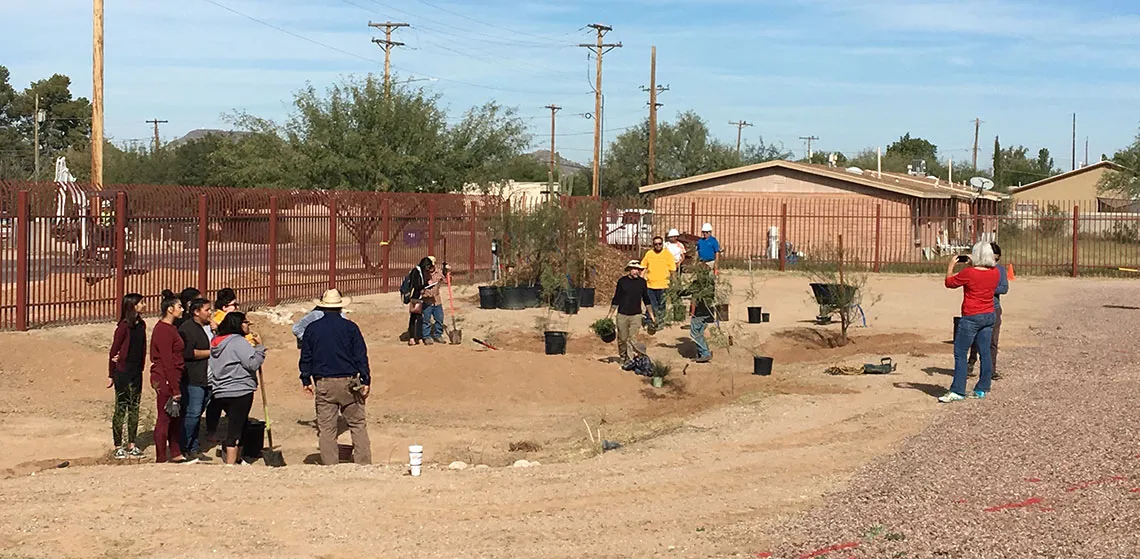Sustainable Built Environments Faculty Provide Insight on New Study of Urban Heat Disparities in Tucson and Other Western Cities

Green infrastructure work at Star Academic High School in Tucson. Photo courtesy Adriana Zuniga.
New research on neighborhood-by-neighborhood heat differences across Tucson—and 19 other cities in the West—has garnered additional insight by Assistant Professor of Planning and Sustainable Built Environments Ladd Keith and Assistant Research Scientist Adriana Zuniga.
The study, published in the International Journal of Environmental Research and Public Health and discussed in an April 4, 2021 article in Arizona Daily Star, used satellites to record temperatures on an “average hot day” on 48 days in each city. “Of the 20 cities, Tucson had the third biggest temperature disparity on average summer days,” states the article. “On extreme heat days and at night, the disparities in Tucson were among the lowest among cities.”
The study demonstrates that, “on an average summer day between 2013 and 2019, late-morning temperatures in the hottest south-side [Tucson] neighborhoods exceeded citywide averages by 7 to 9 degrees Fahrenheit,” says the article. “They topped temperatures in the Catalina Foothills and some northwest-side suburbs by up to 12 degrees Fahrenheit.”
Keith finds that the thermal inequities study is “very important,” and its findings are not surprising considering “what’s shown on a heat island map prepared last year by the regional Pima Association of Governments.” Keith worked on the PAG map.
One notable exception to the heat disparities is the Star Academic High School green infrastructure project, where since 2018 volunteers from the University of Arizona, Sunnyside community and the high school have planted trees, implemented rainwater harvesting and undertaken other measures to green the landscape, provide shade and lower the overall temperature.
Zuniga, who with Geography, Development and Environment Professor Andrea Gerlak led a three-year-long research and outreach project centered around the high school, notes in the Arizona Daily Star article that current city water harvesting and tree-planting rebates and initiatives—which have found some success in wealthier parts of the city—are a challenge in these lower-income neighborhoods.
“The big problem in these low-income areas is that you are exhausted from work,” she says in the article. Residents don’t have time to maintain cisterns, plus their lots are smaller so, “[i]f you have a small lot with a little yard, how much greenery can you put in?”
The article concludes with a review of City of Tucson programs to address urban heat. Read the full article.
Keith, who joined CAPLA in 2009, is an interdisciplinary researcher working at the intersection of urban planning and climate science and explores how climate action planning can make more sustainable and resilient cities. He is currently the principal investigator of a NOAA-funded research project evaluating the use of urban heat maps in urban planning and is co-investigator on a project developing community climate profiles tailored to local needs. In addition to founding and leading CAPLA’s Bachelor of Science in Sustainable Built Environments, Keith teaches public participation and dispute resolution and planning for urban resilience. He contributed to the development and analysis of a number of land use and development regulations, comprehensive plans, hazard mitigation plans and climate action plans and recently completed a full eight-year term on the City of Tucson's Planning Commission.
Zuniga, who joined CAPLA and UArizona’s Udall Center for Studies in Public Policy as an assistant research scientist in 2015, earned her PhD in Arid Lands Resource Sciences and holds a Master of Science in Architecture from the University of Arizona. Her research explores questions related to green infrastructure and urban resilience, environmental justice, water security in cities, groundwater governance and other environmental issues in arid lands. She also teaches courses related to sustainability and the history of the built environment.



